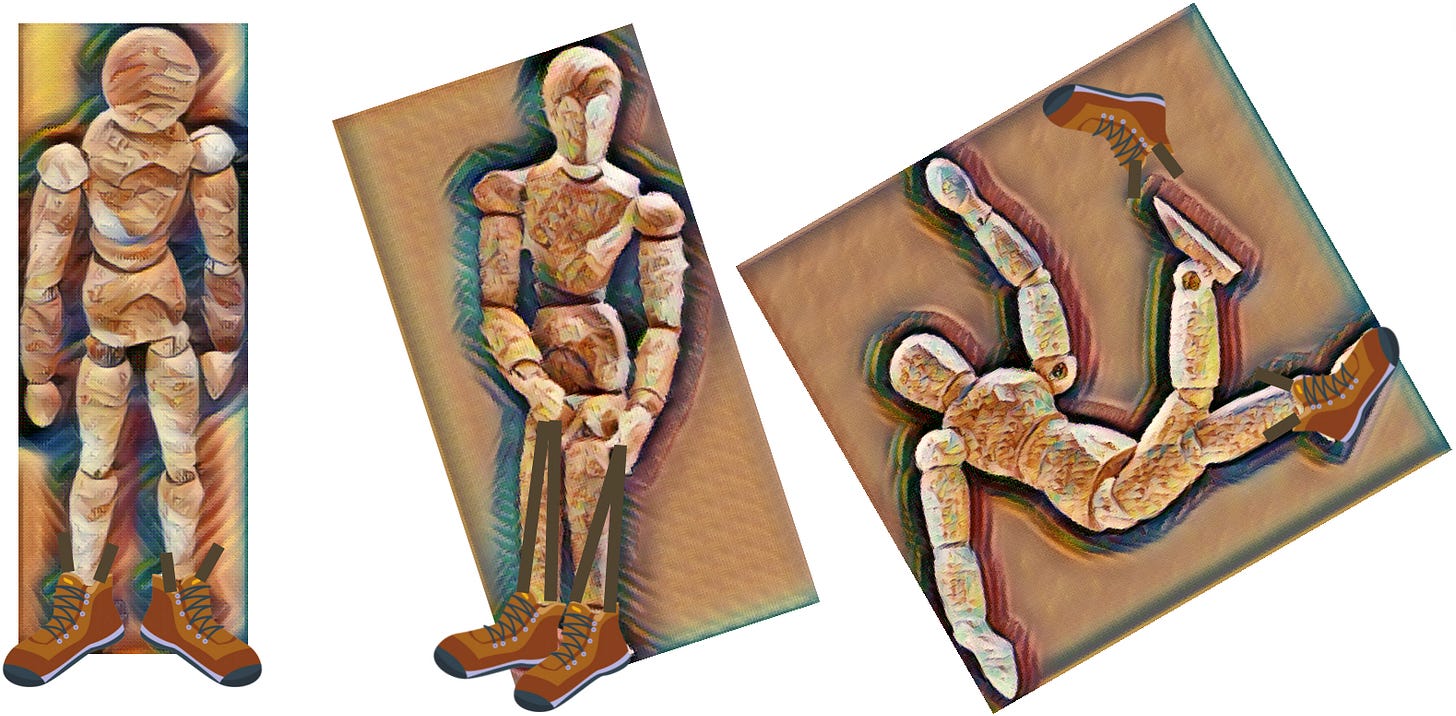Do you know what a bootstrap is? It’s that little loop or tab at the top of a boot. It may in the back, or there may be one on each side. It’s there to help you pull the boot onto your foot.
Do you have a pair of boots like that? I want you to try something with them. Go ahead and get them. I’ll wait.
If you don’t have boots with bootstraps handy, that’s okay. You can do this experiment in your head.
Got them in hand—or in your noggin? Good, now put them on. Don’t be shy. Use those little bootstraps to pull them snug. Great. Now we will do something requiring much more exertion.
I need you to stand up and then squat way down. Now, grab those bootstraps and pull. I mean really pull! Yank yourself right up into the stratosphere.
Now, how does your butt feel? It’s probably where you landed if you made any progress at all. You have now experienced the futility of pulling yourself up by your own bootstraps.
This is one lesson I am not sure I have ever fully absorbed. I call it the Bootstrap-to-Butt Surety.
I say I have never learned the lesson, but my situation is a little more complicated than that. I have always known that the whole bootstrap thing is bogus, but I have, at the same time, utterly imbibed the pull-yourself-up myth. A contradiction, I know, and one that has messed me up my whole life. I think my imbibition stems from a series of experiences from when I was much younger.
After my first year of college, I went home to the Philly suburbs (that is, Delco to the initiated) to work as the technical director of a local theater called Summer Stage, which, amazingly, is still in existence as a theater camp. Back then, it seemed more catch-as-catch can, particularly in the rough-and-tumble scene shop where we built the sets. Most of the actors and crew members were high school and college age with a few adults doing adult things like designing sets and directing plays, which were the usual fair of musicals and shows for the kiddies.
As technical director, I oversaw all aspects of the technical production: sets, lighting, etc. It was a big job even on such a small scale, particularly for an 18 year old. I had a handful of employees, who were all older than I was, and a host of volunteers who ranged in age from about 13 to probably about 30. I was not up to the challenge, but I was too stupid to know it.
The thing is, being in over my head had already become sort of my thing. For example, when I was maybe 12, I ended up in the top leadership position in my little Boy Scout troop because, well, there was no one else. We had a lone adult — the scoutmaster — who worked with us. He was a good guy, but I had no idea what I was doing and almost no guidance because the scoutmaster was himself overwhelmed. When I finally quit at age 14, I was burnt out. Imagine being burnt out at that age. Of course, being stupid, I didn’t understand what I was going through and just figured I had grown too old for scouting.
Summer Stage was similar in that I had little or no guidance in terms of workspace leadership. I knew how to build sets, and I knew enough to delegate the stuff I was not good at, like lighting and painting, but I knew almost nothing about how to move others to get things done. My predecessors in the Summer Stage scene shop pretty much just bullied people until they either fled or did the work. That style was not a natural fit for me.
Since I wasn’t into scaring people off, I had the added burden of managing a bunch of young teens who wanted to help out but had no skills and were a danger to themselves and others around power tools. Now that I think about it, I am damn lucky I never had to transport some kid and their freshly liberated finger to the hospital.
The head of Summer Stage, Harry, was a visionary founder and producer. What he created was pretty special and apparently launched the career of at least one very famous person, some semi-famous people, and a few other more locally renowned theater professionals. I was not among them, by the way, and Harry pretty much left me on my own, which suited me just fine.
Still, my cluelessness made me dangerous.
For the first production that summer, some forgettable musical that I have forgotten, the set designer was an arrogant incompetent who demanded we build a hideous and massive 3d structure (like 20-foot wide by 12-foot tall and three-foot deep) that would rotate on a pivot. I knew this was not going to work but went ahead and built it anyhow with a few key tweaks to give it a better shot of functioning.
Frankly, this thing was unsafe. It was huge and heavy, and sure enough one night my tweaks failed and its pivot broke, causing the structure to roll free, threatening actors and audience alike. The monolith was so big that even a few feet of movement was not readily discernible. Fortunately a sharp-eyed crew member noticed before it tumbled off the stage.
During a scene change we repositioned the structure. Then with one of the smaller teens, I climbed inside so we could reattach the pivot. We had to do our work between scenes when the orchestra was playing to cover the sound of tools. I don’t remember what we did, but somehow we fixed it and got through the final weekend of production without incident.
The following year I was technical director again, and another designer walked in with a crazy set requiring a poorly supported walkway about 10 feet in the air. I divined a clever way to engineer this, but I discovered how close to disaster we came when we dismantled the set at the end of the run. My engineering was on the brink of failure. The production was Annie, and a collapsed walkway would have dumped one group of little chorus girls on top of another.
I should be in jail.
My point here is that, while I got the job done with minimal harm, I could easily have injured or even killed someone with my incompetence. I had no one to guide me, no one to mentor me, no one to turn to. I knew these designs were dangerous, but I went ahead and built them anyway when a more seasoned professional would have refused.
In short, with no mentoring or guidance or even healthy models of leadership, I was bootstrapping all the way. I thought I could do anything, get away with anything, and needed no one. I may have avoided landing on my butt at that moment, but I deserved to, and these types of experiences messed me up for decades in ways I can only begin to understand now. I have bootstrapped my whole life even though I have always known that bootstrapping is bullshit. How many times did I end up on my butt as a result? Looking back it boggles my mind. The good news is I have always strived to learn from my mistakes. Sadly though, some of those mistakes were avoidable and extremely costly.
If you are tempted to say, “But, Jim, you’ve done well in life,” save it. My successes only started racking up when I learned to accept the help of others. And until I learned that lesson, I learned very little else. Worse still, even now I have a hard time accepting help. Bootstrapping is my drug.
My arrogance (for that is what bootstrapping is) was never a substitute for the learning I could have absorbed if I had sought help. Frankly, I have never had a true long-term and trustworthy mentor, and yet I have mentored many toward success. What I learned is what I teach, and my first and most critical lesson is that no one can really do it on their own.
So what is the bootstrap-to-butt surety? It is the assurance that if you do it yourself you will eventually land on your ass, maybe over and over, like me. No one really does it all by themselves. No one. No one is fully self-made despite self-congratulatory claims to the contrary. Everybody needs somebody sometime. Next time someone tells you to pick yourself up by your own bootstraps, give them the boot.
Do you have an impulse to go it alone more often than not? Do you resist when others want to guide you?
You need to reject the bootstrapping myth, and I can help. Click below for your free consultation.
Share your thoughts on this topic or participate in a discussion by leaving a comment below or by contacting me directly by email:
You’ll have to register with Substack and sign in to leave a comment, which is painless and free.
Please share this post on social media.
And don’t forget to click subscribe to have Tools+Paradigms sent directly to your inbox. I look forward to hearing from you.
Intro and outro podcast theme music by LiteSaturation from Pixabay.













